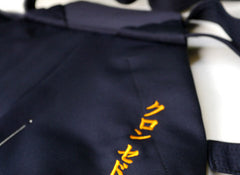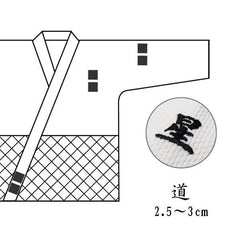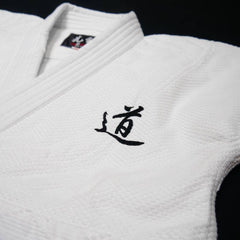-
Japanese Wooden Weapons Craftsmanship, the Beginning of the End | In addition to the structural crisis affecting the industry, in 2019, the closure of one of the largest Japanese workshops, Horinouchi, then, in 2020, the covid crisis have for consequences a drastic increase in prices and production times, and mid-term, a probable disappearance of the manufacture of wooden weapons in Japan. To learn more, you can read our article detailing the situation and the measures taken to help this industry. -
Review Reward Campaign | Leave a comment on your recent purchase and receive a 5% discount.
Embroidery Information
Japanese Style Embroidery on Martial Arts Equipement
In Japan, the inclusion of one's name on one's equipment is very common, it is even sometimes imposed by the teacher. Embroidering one's name is considered as a mark of humility (it means that you do not consider yourself worthy enough of interest for the teacher to remember your name). Beyond that, embroidery, whether on martial arts equipment or not, is an important part of Japanese culture. Athletes, martial artists, waiters in restaurants etc. all commonly have their names on their outfit!
While Japanese people embroider their surnames, westerners usually use their first-names. Although it is much more common in Japan to call a person by their surname name, Japanese teachers are usually aware of this cultural difference and will not hesitate to call foreigners by their first name.
It is also common to embroider the name of club, dojo, or university to which one is attached, whether on the Hakama, jacket, or belt.
Traditional Japanese embroidery was erected as an art. Ninety percent of automated embroidery machines sold worldwide are manufactured in Japan and there is an embroidery workshop at almost every corner! SeidoShop uses a professional embroidery machine (Barudan) of the same type as those used by high-end specialty shops.
Embroideries are available in Roman characters (classic alphabet), katakana (Japanese phonetic alphabet for the transcription of foreign sounds), hiragana (Japanese phonetic alphabet classic), and kanji (Sino-Japanese characters). In the case of a Japanese character embroidery, you can send us a file or write to us when you checkout.
It may be possible to embroider items at other locations than those proposed in our modules or in other fonts and colors, or even to create logos. Contact us if you have a particular query.
Contents
Hakama Embroidery
- Typically, the name of the practitioner goes on the right buttock.
- Japanese writing is usually vertical on buttock and horizontal on koshiita.
- In English, it can be vertical for capital letters, or horizontal for cursive writing.
- The name of the art, style, or school may be placed before the name on the right buttock, or on the koshiita.
- On Koshiita, it is the standard is a horizontal embroidery, in Japanese and English.
- Although it is uncommon, it is also possible to embroider on the inside of the koshiita. In this case, the characters are above our logo and also horizontal.

Positions

Right Hip

Koshiita - Outside

Koshiita - Inside
Aikidogi Embroidery
- Typically, the name of the practitioner goes on the left shoulder or on the collar.
- Japanese writing is usually vertical on the border tail, and horizontal on the sleeve.
- In English, it can be vertical for capital letters and horizontal for cursive writing.
- In cases of cursive writing on the lower collar, embroidery will be moved to the left of the logo (base of the jacket).
- The name of the art, style, or school is usually placed vertically on the chest.
- It is also possible to embroider on the back of the neck or any other position. These options are not available directly on the site, please contact us for any special requests.
- On the pants, embroidery is beside the logo, vertically for Japanese letters, or horizontally for English (cursive font).

Positions

Left Sleeves

Border Tail

Left Chest
Obi (Belt) Embroidery
Two types of embroidery are available for belts: Non integrated embroidery and Integrated embroidery.
Non-integrated embroideries are made on top of the belt stitches and therefore, they are visible on both sides.
Integrated embroideries are made during manufacturing at the workshop and therefore, they will only show on one side of the belt. This latter type is a customization and incurs slightly longer manufacturing times.
- Typically, the name of the practitioner goes to position 1 (logo side).
- The name of the art, style, or school goes to position 2.
- It is possible to embroider the surname, first name, or both.
- In Japanese, embroideries are always vertical.
- You can chose from Kaishotai (classic style font) and Gyoshotai (Cursive/stylized font).
- English cursive embroideries are always horizontal.
- English capital letters are usually vertical (horizontal possible).
- Please note that white and colored belts and the soft black belt model only allow non-integrated embroideries, while all other black belts can have either ones.
- When Aikikai label is selected for a belt, it is stitched to the blank end.

Non Integrated Embroidery

Aikido Embroidery (Non integrated)

Integrated Embroidery

Aikido Embroidery (Integrated)
Embroidery on Other Products
It is possible to embroider almost all of our products. For bags, towels, and name plates (for bags), you can tick the options available on every product page.
There is no common position for this type of embroidery, and if our options do not completely meet your requirements, do not hesitate to contact us to request more information.
Japanese Embroidery & Name Transcription
SeidoShop offers free translation of your name and/or surname. This translation is performed after confirmation of your order based on official transcription tables. If your name is uncommon or the pronunciation is not usual, you can specify it as a comments on each embroidery module, we will contact you if necessary. Transcription of a name can sometimes be done in several ways, including the level of "long" characters. All translations proposed are checked by our native Japanese staff, but if you already have embroidered equipment, the safest way is to send us a photo of the characters (by email) or write them down on the "other instructions" field available on all embroidery modules. Note that we do not accept any complaint concerning a possible difference with a translation that you might have if you have not sent us your request prior to manufacturing.
Japanese is written using three separate alphabets. The kanji characters are Sino-Japanese from China, they are complex, and are stylized semi semantics. They have from one to a dozen different pronunciations for the same character depending on the context. Hiragana and katakana are two alphabets that can express existing sounds in the Japanese language (Ka, Mi, Kou Shi, etc.). Kanji are mainly used for writing common names, Japanese verbs and surnames. The primary function hiragana writing is as part of grammar and conjugation as well as simple words and some Japanese names.
Katakana are used for the transcription of words and names of foreign origin, allowing the Japanese to pronounce any foreign word using their own sounds (adaptation). The foreigners' names are translated into katakana, with very few exceptions. It is this "official" translation that we offer automatically and free of charge. Please note that if your request is for initials, it will not be translatable in Katakana and will be embroidered in roman alphabet with the selected font.
It is possible to translate a foreign name in kanji, choosing characters whose pronunciation is approaching, it is known as the "ateji" technique. However, for the same name, there may be hundreds of combinations, and since it is not customary for foreign residents in Japan to translate their name in kanji (this can lead to misunderstandings), we do not offer translation of names into kanji.

Embroidery in English
It is possible to embroider your name in Japanese but also in English or "Roman" alphabet. Since originally, embroidery is a mark of humility, alphabet writing seems more appropriate if it is to be read by a non-Japanese teacher. You will find various options in the chapter "Writing & Fonts."
It will be necessary however to embroider one's name in katakana for those wishing to visit Japan, as many Japanese are unable to "read / pronounce" the Western alphabet.
Embroider a Japanese Word or Phrase
If you want to embroider the name of an art or a Japanese school, simply indicate it in English in the module for embroidery. E.g. if you enter "Aikido" or "Iwama Ryu", then select the language "Japanese", we will automatically transcribe it into Kanji.
If you want to embroider the translation of an English word in Japanese, enter the English word, we will do the translation. E.g. if you enter "Tiger" then select the language "Japanese", we will translate it into "Tora" (Tiger). We will contact you if the translation is subject to interpretation.
If you already have a translation of your name, you can attach a picture or a text file on all embroidery/engraving modules. This is totally optional the translation of your name is free. Whenever possible, for dojo names and other specific expressions, please attach a file for all prints. Please note that several translations sometimes exist for the same name and that we cannot accept claims if an alternative translation to that which you were expecting was provided with your order unless you attached a file to your order with the specific characters desired.
For any complex expression, please contact us before you order. Although most common expressions have an equivalent in Japanese, this is not always the case.
Embroidery of Logos & Designs
We can of course offer this service, however, the charge varies according to the complexity of the logo, number of colors, etc. You will need to contact us beforehand so we can provide a quote.
Please note that we will not take into account any logo embroidery requests ordered through the standard embroidery module.
- Multiple colours: maximum 4 colours, chosen from the embroidery colour palette.
- Maximum size: approximately 12 x 12 cm.
- Graphic charges: for designing the logo (to be paid once, the logo is kept for 10 years): between 2,000 YEN and 10,000 YEN. These costs depend mainly on the complexity of the logo (complexity of the shape, size of the smallest elements) and are estimated by our graphic designer within 3 days after receiving your request.
- Embroidery fee: depending on the size of the logo, between 2,000 YEN and 5,000 YEN. Charged per embroidery.
- Delivery: 1 to 2 weeks.